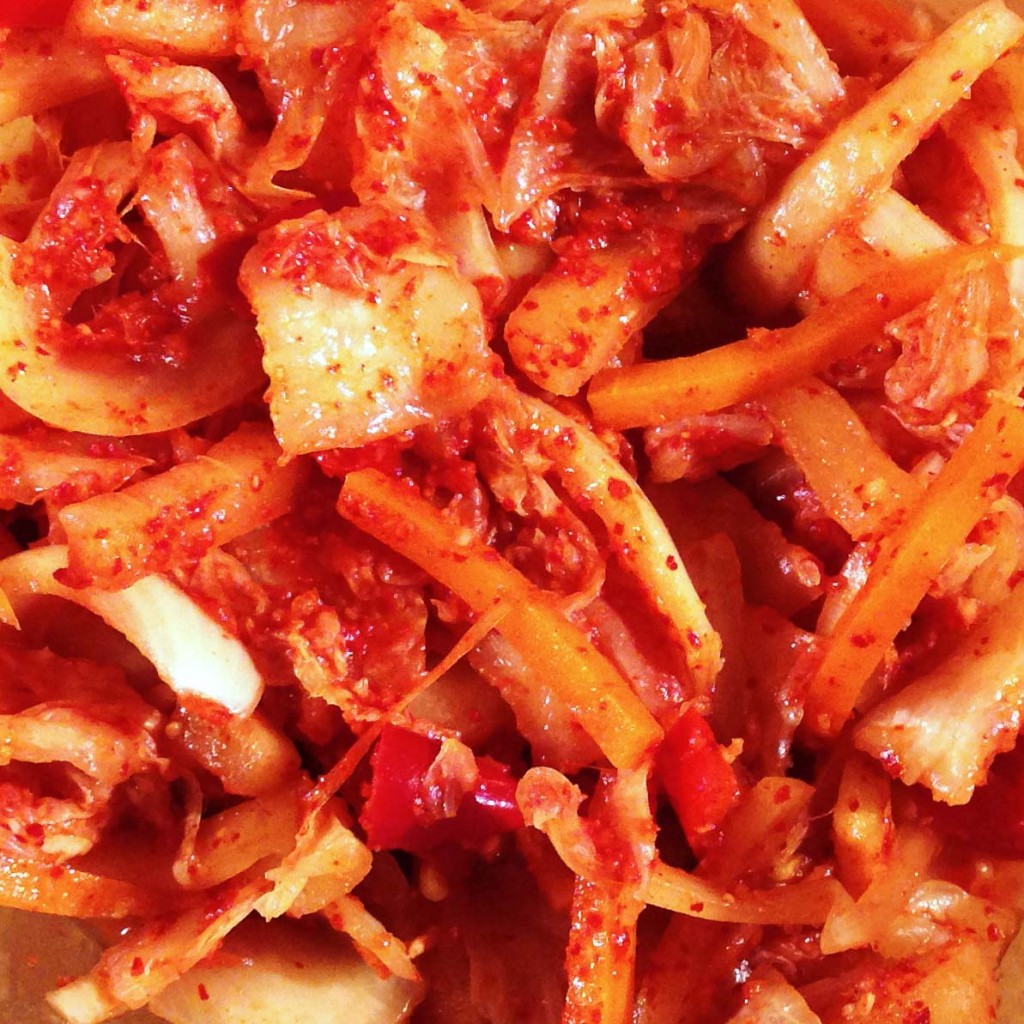One of the oldest methods for preserving foods is fermentation – people have been fermenting their foodstuffs for thousands of years. Not only does it help the food keep for longer, it can make it easier to digest, and most importantly, it adds a whole wealth of interesting flavours. The list of fermented foods is long – yoghurt, creme fraiche, beer, wine, cider, miso, soy sauce, tempeh, kefir, worcestershire sauce, and many, many more. In this challenge, however, we’re going to focus on the fermentation of one particular vegetable: cabbage.
Fermented cabbage is found all over the world – the Europeans have sauerkraut, the Japanese have tsukemono, the Chinese have suan cai, but the one Anya is going to make is the Korean kimchi.
There are many varieties of kimchi, and probably as many recipes as there are people who make it. Very commonly however, it consists of a mixture of chopped chinese leaf (napa cabbage), daikon radish and onions, salted and then mixed with garlic, ginger and chilli, and then left to ferment.
I’ve made kimchi a good few times now, and I often put a variety of different vegetables in. My recipe typically goes something like this:
- 500g Chinese cabbage
- 1 daikon radish
- 1 red pepper
- 2 or 3 carrots
- 250g sugar snap peas
- 2 or 3 onions
- a bunch of spring onions
- 12 large cloves garlic
- 6 hot red chillies
- 4 inch piece of ginger, roughly chopped
- ½ cup fish sauce
- Korean chilli powder
- sea salt
Coarsely chop the cabbage, and cut the radish, pepper and carrots into thin strips. Place in a large bowl. Mix up some brine – about 4 tablespoons of sea salt to each litre of water and add enough brine to the bowl to just cover the vegetables. Place a plate on top of the vegetables to keep them below the surface and leave overnight.
Next day, drain the vegetables (reserving some of the brine). Cut the onions and chillies into thin strips and add to the mix.
Put the garlic and ginger into a blender, with a little water and blend until smooth. Don’t skimp on these – kimchi can absorb vast quantities of these flavours – you can add even more if you like. Add the blended garlic and ginger, together with a generous measure of the Korean chilli powder, into the vegetables and mix thoroughly so it’s distributed evenly throughout. Now add the fish sauce – do check the label on the fish sauce though, to ensure it’s free of preservatives – they would interfere with the fermentation process.
Place the kimchi in a crockpot, jar or other suitable container – preferably glass or ceramic. Press the kimchi down with a plate, weighting it if necessary, and you’ll see more brine appear. If the brine doesn’t cover the vegetables, top up a little with your reserved brine. Cover the pot with a lid or cloth to stop things falling in and place in an out-of the way spot in the corner of kitchen. Now for the hard bit: wait.
It will take at least a week, probably two, before the kimchi is ready – if the weather’s cool, it will take rather longer than if it’s warm. Check the kimchi each day, topping up with a little brine if the liquid level has fallen. Taste it every now and then, and after a while you’ll find it’s developed a distinctively sour note. The longer you leave it, the more pronounced the sourness will be – how far you go is really a matter of personal preference, don’t be afraid to experiment. Once your kimchi is ready, store it in a cool place, to help slow down further fermentation.
Of course, that’s just my recipe. Anya should do a little reading around and decide for herself what to make. I’ve always found Sandor Ellix Katz’s books (Wild Fermentation and The Art of Fermentation) to be an invaluable resource when learning about fermented foods, and there are a number of websites that are well worth a visit: The Wild Fermentation forums provide many answers to questions, and plenty of food blogs include posts on their experiences with lacto-fermentation – a quick Google search should reveal many useful sources of information.
Challenge #9
Make kimchi.

Come on Anya! Where’s your kimchi? It’s good for you.